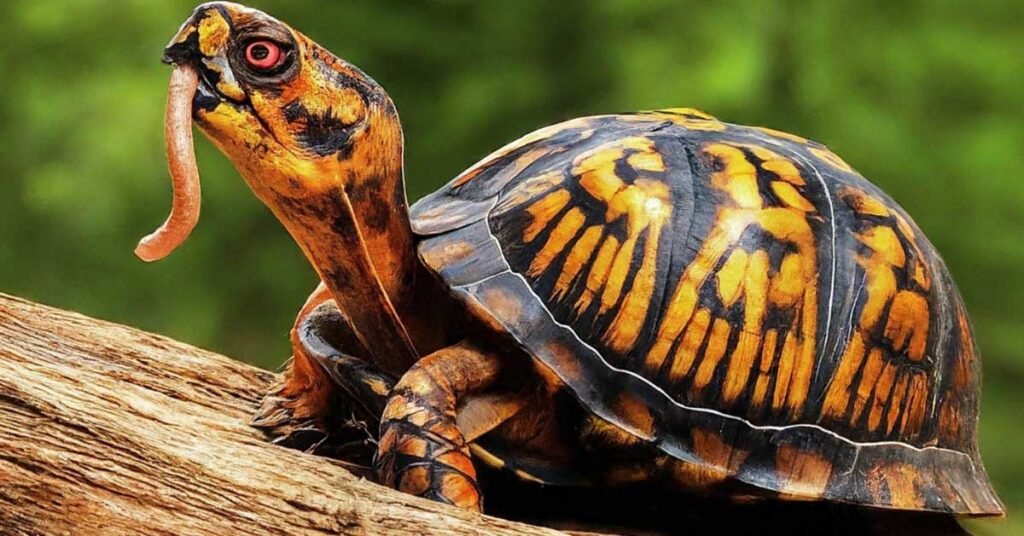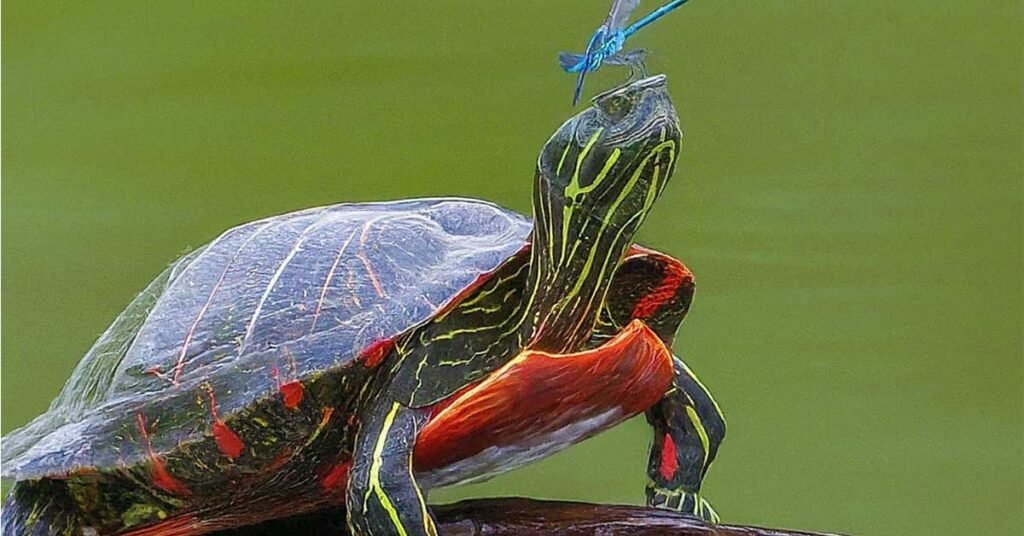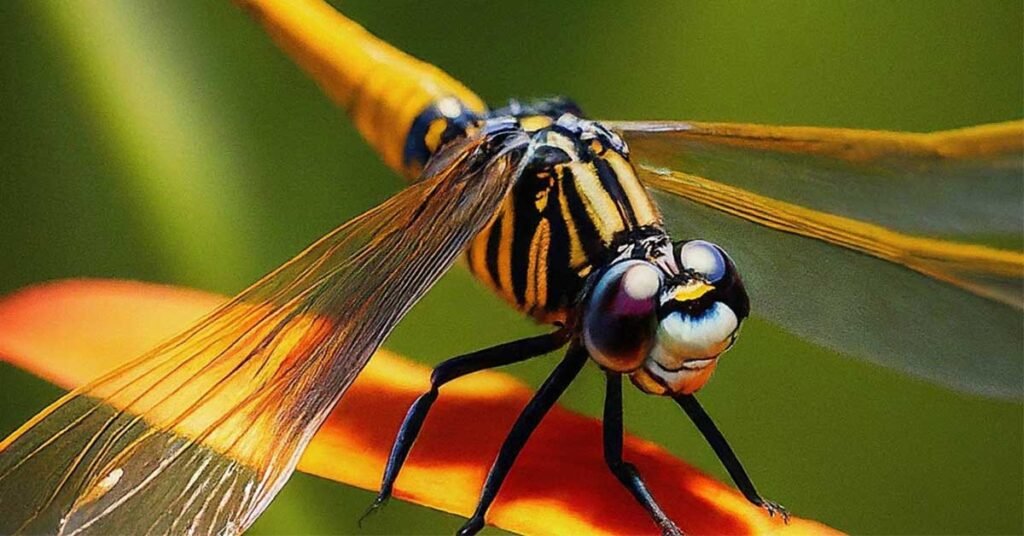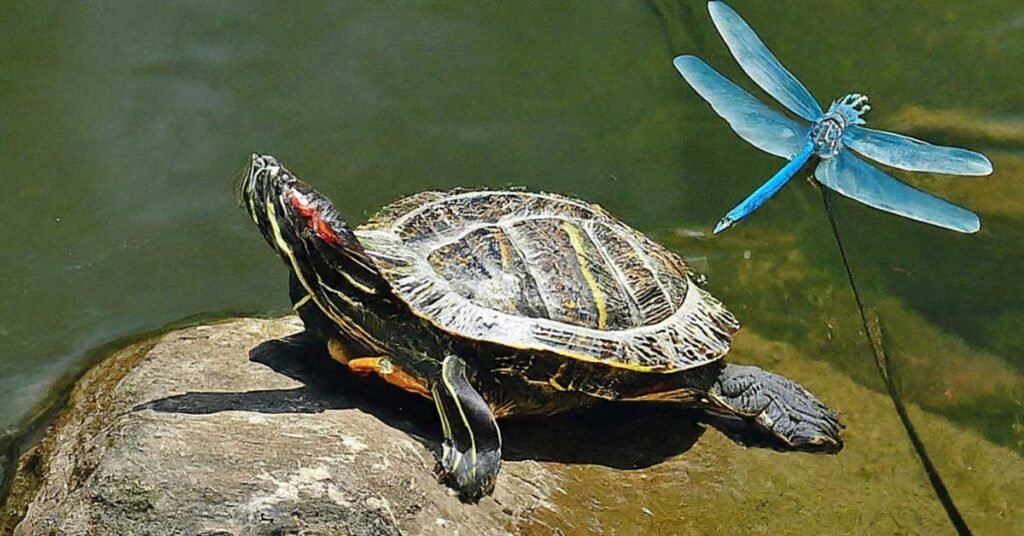Turtles are fascinating creatures with diverse tastes. We all know they love eating greens and meat meals. But as a carnivore diet, do turtles eat insects, too? The good thing is that they are safe to eat insects. These little creatures can be a valuable part of a turtle’s healthy diet.
In the wild, turtles are omnivores, and they enjoy a mix of plant and animal-based foods. Insects like crickets, worms, and grubs often make their way onto a turtle’s menu. Think of them as nature’s protein bars for these shelled friends! But just like us, a balanced diet is key.
In this article, we’ll explore the specifics of whether turtles eat insects, the types of insects they consume, and how to incorporate insects into their diet.
Do Turtles Eat Insects?

Yes, they do. Turtles might seem like eating leafy greens all day, but their taste buds go well with meat – they love insects. Insects are a super healthy snack for turtles, full of protein energy that helps them grow strong and healthy. Think of them as tiny turtle power pellets.
In the wild, insects are turtles’ go-to food. They’re plentiful, easy to catch compared to other prey, and perfect for a quick and nutritious bite. When you see a turtle basking, remember they might be dreaming of crickets instead of salad.
What Insects Do Turtles Eat?

We already know that turtles have a good taste for insects. But with so many different critters out there, which ones make the tastiest and healthiest meals for our shelled friends?
Worms
Worms are an excellent insect option. They’re another great source of protein, and many turtle owners say turtles happily savor worms. However, it’s important to note that worms can be tricky for young turtles to digest, so they’re best for older turtles who can handle them safely. Also, remember, moderation is key – too many worms can cause tummy troubles.
- Mealworms: These wriggly beetle larvae are a bit larger than crickets and offer a good source of protein and fat. Since they’re high in fat, serve them in moderation.
- Earthworms: Packed with moisture and nutrients, earthworms are a great occasional treat for some turtle species. However, due to their low calcium content, avoid using them as a staple food.
Crickets
Crickets are like pizza in the turtle world—popular and nutritious. Full of protein and calcium, they help turtles grow big and strong. The best part? Catching crickets can be like a fun game for your turtles, keeping them active and engaged. Just be sure to supervise feeding times to avoid allowing crickets to escape.
Bug Bonanza
Beyond crickets and worms, there’s a whole world of turtle-approved bugs. Beetles, caterpillars, and even cockroaches can all be part of a healthy turtle diet. These guys offer a protein punch and variety to keep your turtle’s meals interesting.
Other Insects
Here is another option some turtle species might enjoy, depending on their size and preferences:
- Soldier Fly Larvae: These wriggly guys are nature’s tiny protein and calcium bars for turtles. Packed with both nutrients, they’re a great way to keep your turtle growing strong and healthy.
- Grasshopper: Grasshoppers might surprise you, but they can actually be a delightful and nutritious snack for some turtle species. These little jumping insects are stuffed with protein, which helps turtles grow big and strong. They’re also relatively easy to catch in the wild, making them a natural part of a turtle’s diet in their habitat.
- Caterpillars: Some turtle species enjoy eating caterpillars they find in the wild. However, commercially raised options are safest for pet turtles, and these should only be offered as occasional treats.
Feeder Insect Must-Knows: Although this insect buffet is exciting, make sure you only feed your turtle insects that are safe and commercially explicitly raised for reptiles. Some insects carry parasites or harmful chemicals.
If you do your research and choose the suitable insects, you can make a tasty and nutritious insect menu for your turtle.
The Nutritional Power of Insects for Turtles

Insects might seem like simple bugs, but for turtles, they’re a nutritional powerhouse. Let’s take a closer look at the fantastic benefits insects offer your shelled friend’s health:
Protein
Insects are packed with protein, a vital nutrient for growing turtles. Protein helps build strong muscles, repair tissues, and keep your turtle feeling energized.
Fats
Don’t be fooled by the word “fat”! Insects contain healthy fats that play a crucial role in your turtle’s development and overall health. These fats help your turtle absorb vitamins, maintain healthy skin, and even provide a source of energy. However, a balanced diet is crucial, so avoid using fatty insects as a staple food.
Vitamins
Many insects are a natural source of essential vitamins like A and E. Vitamin A supports healthy vision and growth, while Vitamin E acts as an antioxidant, protecting your turtle’s cells from damage.
Minerals
Insects can be a great source of essential minerals like calcium and phosphorus. Calcium is crucial for strong bones and shell development, while phosphorus works hand-in-hand with calcium for optimal bone health.
Prebiotics
Some insects contain prebiotic fiber, which promotes healthy gut bacteria in your turtle’s digestive system. This good bacteria aids digestion and nutrient absorption, keeping your turtle’s tummy happy and healthy.
While insects are healthy, make sure you choose a variety of feeder insects raised specifically for turtles. This guarantees that they’re clean, nutritious, and perfect for turtles.
What Type of Insects to Avoid for Turtles

Turtles may be insect enthusiasts, but some critters should not be included in their palate, even if they are interested in them. Here’s a heads-up on insects to avoid feeding your pet turtle:
Mosquitoes: While turtles might encounter mosquitoes in the wild, these bloodsuckers are a no-go for captive turtles. The blood they carry can harbor diseases that can jump from the mosquito to your turtle.
Flies: Those pesky flies might seem like easy prey, but they’re more trouble than they’re worth. They’re challenging for turtles to catch, and even dead flies can carry icky germs that could make your turtle sick.
Say No to Slugs & Snails: These slimy garden dwellers might seem like a tempting snack. However, they can hitch a ride on nasty parasites that can make your turtle very uncomfortable. Also, snail shells can be too tough for turtles to digest, leading to tummy aches.
Do Your Research Before You Feed: The world is full of fascinating insects, but not all of them are suitable for your turtle’s diet. Before offering your turtle a new insect, do some research to ensure it’s safe and nutritious. There might be surprise insects out there that can be harmful, so a little research goes a long way to protecting them.
Remember: For a happy and healthy pet turtle, stick to commercially raised feeder insects specifically meant for reptiles. They’re the cleanest and safest way to keep your shelled friend smiling.
How To Feed Insects to Your Turtle
There are a few things to remember to ensure a happy and healthy turtle when feeding them insect buffets.
- A Little Dip Before the Dive: Here’s a cool trick – try placing the insects in shallow water before offering them to your turtle (except box turtles, who can eat them dry). This serves a double purpose: the water hydrates the insects, making them easier for your turtle to digest. It also prevents them from escaping the dinner plate!
- Treats, Not Staples: Insects are filled with protein, which is excellent for turtles. However, you have to serve in the right balance. Treat your turtle to insects once or a few times a week, not as their everyday food. It is a fun and nutritious snack, but too much protein can cause shell problems and tummy troubles.
- Start Slow, Go Steady: If your turtle is a newbie to the insect world, take things slow. Begin with a small amount of insects to allow their digestive system to adjust to this new food source. Once they’re comfortable, you can gradually increase the amount based on your turtle’s size and needs.
What insects do box turtles eat?
Box turtles eat crickets, mealworms, waxworms, and other insects. These insects provide essential nutrients and variety in the turtle’s diet. Box turtles need protein to grow and thrive, so adding a mix of these insects gives them a balanced diet.
What insects do painted turtles eat?
Painted turtles eat a diverse insect diet based on what’s around them. They typically munch on larvae, dragonflies, and beetles, snagging anything near water. Mealworms and crickets are popular choices for pet-painted turtles due to their easy availability.
Do all turtles eat insects?
Absolutely, nearly all turtles have a taste for insects. They find insects beneficial due to their high protein content, aiding in their growth. Insects comprise a significant part of a turtle’s diet in their natural habitat.
Read More: Can Turtles Eat Peas?
Conclusion
Turtles eat crickets, mealworms, waxworms, and other insects. These insects provide essential nutrients and variety in a turtle’s diet. They need protein to grow and thrive, so adding a mix of these insects gives them a balanced diet.
Of course, it’s essential to stick with commercially raised feeders and offer them in moderation. However, a well-chosen insect snack can be a fun and nutritious part of a turtle’s diet.
